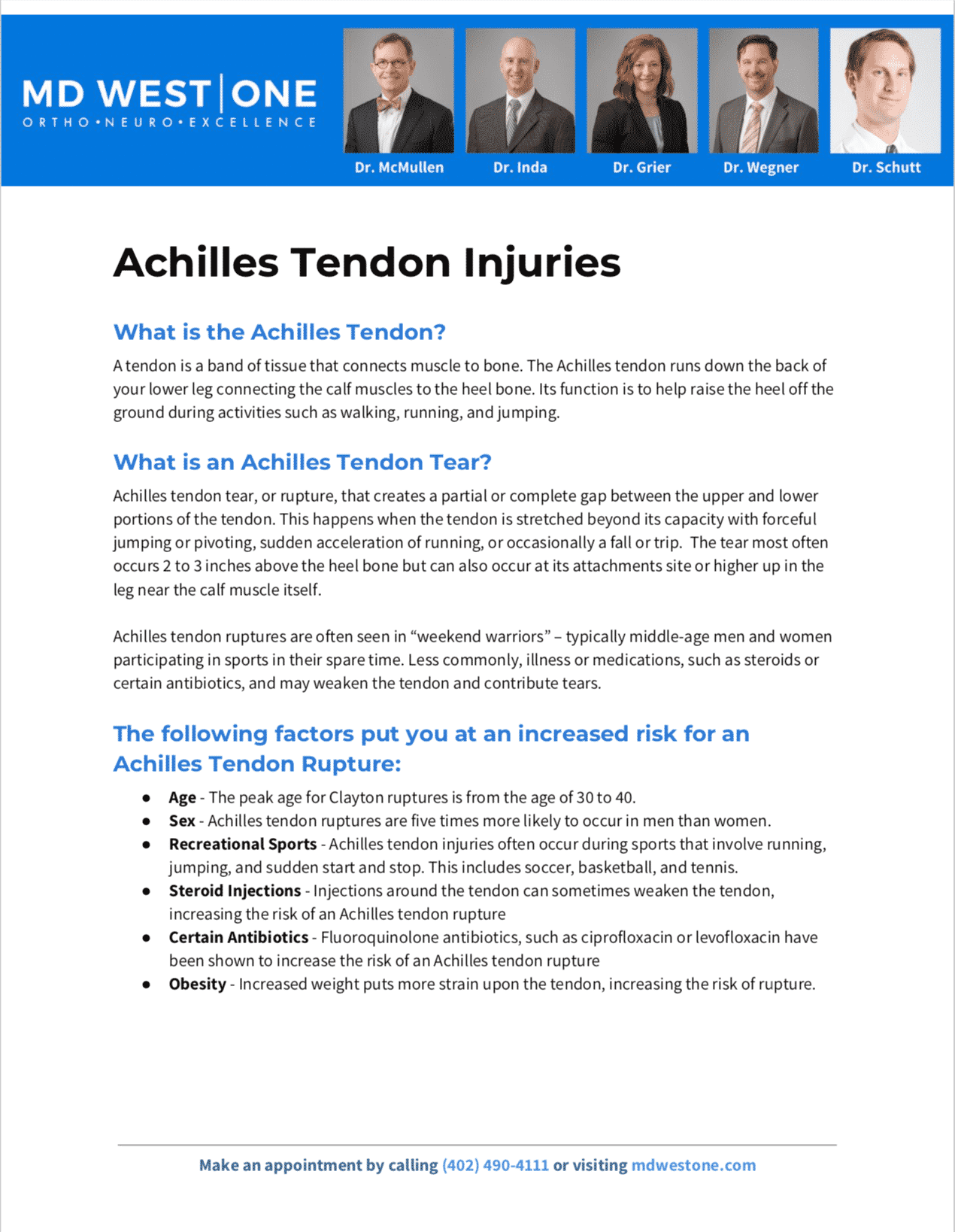Are you suffering from a potential Heel Bone Fracture?
The Omaha Foot & Ankle Specialists at MD West ONE are able to properly diagnose and treat Heel Bone Fractures through both surgical and non-surgical treatments. If you have the following symptoms, you may want to make an appointment with one of our Board Certified Specialists.
- Pain
- Bruising
- Swelling
- Heel deformity
- Inability to put weight on the heel or walk
Meet MD West ONE's foot and ankle specialists and learn more about how they treat Heel Bone Fractures.
Heel Bone Fracture Causes, Treatments & Surgery
What is a Heel Bone Fracture?
Calcaneus fractures can be quite severe. Treatment often involves surgery to reconstruct the normal anatomy of the heel and restore mobility so that patients can return to normal activity. But even with appropriate treatment, some fractures may result in long-term complications, such as pain, swelling, loss of motion, and arthritis. Many patients with labor-intensive jobs are unable to return to their job after a calcaneus fracture.
The following factors put you at an increased risk for a Heel Bone Fracture:
The calcaneus is most often fractured during a fall from a height or a motor vehicle collision
The severity of a fracture can vary, although most are caused by a violent impact. For example, a simple twist of the ankle may result in a single crack in the bone. The force of a head-on car collision, however, may result in the bone being shattered (comminuted fracture).
Similar fractures can result from different mechanisms. For example:
-
If you land on your feet from a fall, your body's weight is directed downward. This drives the talus bone directly into the calcaneus.
-
In a motor vehicle crash, the calcaneus is driven up against the talus if the heel is crushed against the floorboard.
In both cases, the fracture patterns are similar. As a rule, the greater the impact, the more the calcaneus is damaged.
In a high-energy fracture, other injuries, such as fractures of the spine, hip, or other heel, can occur.
Ways to Decrease Your Risk of Developing Heel Bone Fractures:
- Avoid major falls
- Avoid automobile accidents
DIAGNOSIS
Imaging studies will help confirm the diagnosis of a calcaneus fracture:
X-rays. X-rays, the most common and widely available diagnostic imaging technique, create images of dense structures, such as bone. An X-ray can show whether your calcaneus is broken and whether the bones are displaced.
Computed tomography (CT) scans. Because of the complex anatomy of the calcaneus, a CT scan is routinely ordered after a fracture has been diagnosed on X-ray. A CT scan will produce a more detailed image of your foot than an X-ray and can provide your doctor with valuable information about the severity of your fracture. This information will help your doctor recommend the best plan for treatment.
Your doctor may share both your X-rays and CT scans with you to help you better understand the nature and severity of your injury.
NON-SURGICAL TREATMENT OPTIONS
Your doctor may recommend nonsurgical treatment if the pieces of broken bone have not been displaced by the force of the injury.
Immobilization. A cast, splint, or brace will hold the bones in your foot in proper position while they heal. You may have to wear a cast for 6 to 8 weeks — or possibly longer. During this time, you will not be able to put any weight on your foot until the bone is completely healed.
SURGICAL TREATMENT OPTIONS
If the bones have shifted out of place (displaced), your doctor may recommend surgery.
Surgery to repair a calcaneus fracture can restore the normal shape of the bone but is sometimes associated with complications, such as wound healing problems, infection, and nerve damage.
Nonsurgical treatment of some fractures, however, can also lead to long-term complications, such as pain, arthritis, and a limp. Your doctor will review the details of your injury and talk with you about the risks and benefits of surgical versus nonsurgical treatment.
Timing of surgery. If the skin around your fracture has not been broken, your doctor may recommend waiting until swelling has gone down before having surgery. Elevating your leg and keeping it immobilized for several days will decrease swelling. It will also give injured skin a chance to recover. Waiting before the operation may improve your overall recovery from surgery and decrease your risk of infection.
Open fractures, however, expose the fracture site to the environment — increasing the risk of infection — and must be treated immediately. They require surgery to clean the wound and remove damaged tissue.
Early surgery may also be recommended for other fractures. Although uncommon, a piece of the calcaneus can be pulled off when the Achilles tendon splits away from the bone (avulsion). For this type of fracture, emergent surgery can decrease the risk of injury to the skin around the Achilles tendon.
Surgical procedure. The following procedures are used for various types of calcaneus fractures:
- Percutaneous screw fixation. If the bone pieces are large, they can sometimes be moved back into place without making a large incision. Special screws are then inserted through small incisions to hold the fracture together.
- Open reduction and internal fixation. During this operation, an open incision is made to reposition (reduce) the bones into their normal alignment. They are held together with wires or metal plates and screws.
Bones have a remarkable capacity to heal. The more severe your injury, however, the longer your recovery may be. Patients with more severe fractures are also more likely to suffer some degree of permanent loss of function, regardless of treatment.
POST-OPERATIVE RECOVERY
After surgery, you will feel some pain. This is a natural part of the healing process. Your doctor and nurses will work to reduce your pain, which can help you recover from surgery faster.
Medications are often prescribed for short-term pain relief after surgery. Many types of medicines are available to help manage pain, including opioids, non-steroidal anti-inflammatory drugs (NSAIDs), and local anesthetics. Your doctor may use a combination of these medications to improve pain relief, as well as minimize the need for opioids.
Be aware that although opioids help relieve pain after surgery, they are a narcotic and can be addictive. Opioid dependency and overdose have become critical public health issues in the U.S. It is important to use opioids only as directed by your doctor and to stop taking them as soon as your pain begins to improve. Talk to your doctor if your pain has not begun to improve within a few days of your surgery.
Whether your treatment is surgical or nonsurgical, your rehabilitation will be very similar. The time it takes to return to daily activities will vary depending on the type and severity of the fracture and whether you have other injuries.
Some patients can begin weight-bearing activities a few weeks after injury or surgery; most will need to wait 3 months before putting weight on the heel. Some patients are able to begin partial weightbearing 6 to 10 weeks after injury or surgery.
- Early motion. Many doctors encourage motion of the foot and ankle early in the recovery period. For example, you may be instructed to begin moving the affected area as soon as your pain allows. If you have had surgery, you may be instructed to begin moving the affected area as soon as the wound heals to your doctor's satisfaction.
- Physical therapy. Specific exercises can help improve the range of motion in your foot and ankle, and strengthen supporting muscles. Although they are often painful at the beginning and progress may be difficult, exercises are required in order for you to resume normal activities.
- Weight bearing. When you begin walking, you may need to use crutches, a cane, or a walker and/or wear a special boot. It is very important to follow your doctor's instructions for walking on your foot. If you put weight on your foot too soon, the bone pieces may move out of place and you might require surgery. If you have had surgery, the screws might loosen or break and the bone may collapse. This may not occur the first time you walk on it, but if the bone is not healed and you continue to bear weight, the metal will eventually break.
Frequently Asked Questions?
What are complications?
Complications often occur with calcaneus fractures. Minor complications include:
- Small or temporary areas of delayed wound healing
- Nerve irritation around the incision
- Tendon irritation
- Joint stiffness
- Chronic pain
- Chronic swelling
Major complications include:
- Failure of the wound to heal
- Infection
- Posttraumatic arthritis (with or without surgery)
It is important to tell your doctor if you are a smoker. Smoking affects both bone and wound healing. With or without surgery, your bone may take longer to heal if you smoke.
Additional surgery is usually required in cases of infection or wound healing complications. If all attempts to resolve an infection or a wound healing complication fail, an amputation may be necessary.
If your injury is minor, such as a crack in the bone with little muscle damage, you may be able to resume normal activities 3 to 4 months after surgery. If your fracture is severe, however, it may take 1 to 2 years before recovery is complete.
Despite the best efforts of the doctor and patient, patients rarely regain normal foot and ankle motion after a severe fracture and do not typically resume their pre-injury level of function. A patient who is not very active might tolerate a foot that is not normal. On the other hand, a patient whose job or recreational activities require a lot of walking or climbing may require major lifestyle and career changes.
What are common problems?
Common problems that may persist after recovery include:
- Skin irritation. Footwear can irritate the skin or tendons in the affected area.
- Altered gait. In some cases, the arch of the foot has not been restored, or the Achilles tendon has not healed at its normal distance from the ankle. Full motion between the talus and the calcaneus is rarely regained in these cases, and this can change the way you walk. You may have problems walking on uneven ground, such as grassy surfaces or hills.
- Pain. After a fracture, you may experience continued subtalar pain and limited motion. Even if the heel anatomy is perfectly restored, you may still have discomfort. This can happen because of injured soft tissues, persistent fracture displacement, arthritis, or limited ankle and subtalar range of motion. Although relatively uncommon, pain can also be caused by irritation from the plates or screws.
AMERICAN ORTHOPAEDIC FOOT & ANKLE SOCIETY
All of the foot and ankle surgeons in the practice are recognized members of the American Orthopaedic Foot & Ankle Society. It is the oldest and most prestigious medical society dedicated to the foot and ankle. The mission of the society is to advance science and practice of foot and ankle surgery through education, research, and advocacy on behalf of patients and practitioners. These physicians dedicate their time and energy to improving the patient experience and their knowledge in their field. For more information visit http://www.aofas.org.
MD West ONE Foot & Ankle Specialists:
The Foot & Ankle Specialists are all Board Certified and Fellowship-Trained, meaning they’ve focused their education, training and research on orthopaedic surgery of the foot and ankle.






